Care-a-Van
class project @ harvard GSD
TEAM —
Elif Erez, Geráud Bablon, Maggie Chen, Snow Xu
TIME SCOPE —
3.5 months
METHODS —
︎ Secondary Research (Partial Contribution)
︎ Stakeholder Interviews (Partial Contribution)
︎ Implementation Strategy (Partial Contribution)
︎ Site Visit
︎ Mapping
︎ Rendering
Keywords: Research, Implementation, Aging, Accessibility, Public Policy, Community Engagement, Intergenerational Exchange, Culture, Food
CONTEXT
Background on Aging
America’s population is rapidly aging, as literatures often speak of a “tsunami” or a “crisis” of aging. Americans over the age of 65 are projected to more than double and reach 80 million in 2040 [1].
We are inspired by the beauty of old age, but we live in a culture that fails to recognize values in the wisdom and perspectives of elders with rich life experiences, and we rarely observe intergenerational engagements beyond familial bonds (and in the U.S., elders are still less likely to be living with extended family [2].)
(We stumbled across some cool examples of older adults adhering to more youth-centric roles - and absolutely killing it - [3] [4] [5] [6] [7]. On the other hand, these podcasts speak to some of the struggles older adults face - [8] [9].)
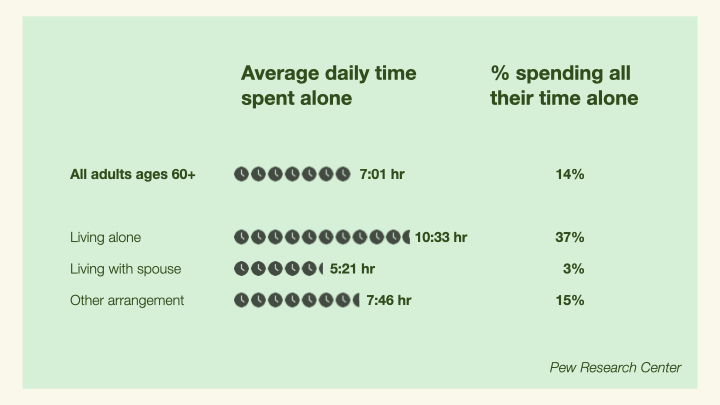
Older adults are spending more time alone [10].
Aging is often stigmatized, and older adults are undervalued. Local governments like states and municipalities and non-profits offer a range of services to meet some needs of older adults, such as healthcare, transportation, and programs like volunteer services and senior centers, which address some of the elders‘ survival and social needs.
After conducting extensive primary and secondary research, we found opportunities to further develop social infrastructures that enrich elders’ social and emotional lives - through programming that encourages intergenerational engagement that creates reciprocal exchange - rather than just making older adults burdens/care recipients.
SOCIAL INFRASTRUCTURE FOR OLDER ADULTS refers to the underlying structures that sustain social life, including spaces of sociability and care.
Furthermore, instead of simply brainstorming how to build social infrastructures for elders, we have pivoted to consider older adults as social infrastructure, as they offer invaluable support and wisdom to our society - e.g. Older adults in the U.S. are embedded in civic infrastructure, providing valuable services essential to democratic practices like polling and voting [11].
Proposed Design: Care-a-Van
Proposed Design: Care-a-Van

We propose the design and implementation of Care-a-Van, a mobile dining hall and community hub that goes around different local neighborhoods to host intergenerational programs. It...
- Brings private work done by volunteers in people’s homes into open public spaces
- Takes the work of non-profits & senior centers inside their facility space outside into the community
We have focused on food-related programming that encourages story-telling as a way to pass down cultural heritage.
Note: Care-a-Van is featured as a distinguished student project on the Harvard Graduate School of Design website.
Note: Care-a-Van is featured as a distinguished student project on the Harvard Graduate School of Design website.
METHODS
Site Visit + Secondary Research
Cambridge, MA, is a prime case study and the focus of our project for its relatively well-developed infrastructure for elder services and geographic accessibility.
We conducted site visits of a local senior center, and from primary and secondary research, we managed to map out the landscape of local facilities and organizations that work with elders and visit key sites like the Citywide Senior Center.
![]()
![]()
To better understand existing infrastructure and programs servicing older adults in Cambridge, we conducted interviews with a few stakeholders in the local network of facilities and organizations:
Arline McGrady, Event Coordinator @ Cambridge Senior Center
Colleen Morrissey, Director of Volunteers & Special Projects @ Somerville Cambridge Elder Service
Micheline Federman, representative on the Advisory Council @ Somerville-Cambridge Elder Services (SCES), volunteer @ the Money Management program
Vincent McCarthy, Director of Client Services @ Cambridge Council on Aging
Susan Stockard, retired property management executive, who directed a research project on models for delivering health and social services to elders in public housing.
We were also in touch with Boston’s Executive Office of Elder Affairs (EOEA) and learned more about the broader policy landscape and outlook on aging and elder services in Boston.
We learned that Boston/Cambridge is actually well-equipped in terms of elder services and infrastructure, despite which, we identified 3 major challenges:
“People don’t want to go to a ‘senior’ center.”
“They don’t want to admit that they need help with something so personal.”
DESIGN
Care-A-Van
Care-a-van is a mobile dining hall and community hub that goes around different local neighborhood to host intergenetaionl programs. it brings private work done by volunteers inside people’s homes into open public places, or takes the work of non-profits & senior centers inside their facility space outside into the community. We are focusing on food-related programming that encourages story-telling as a way to pass down cultural heritages.
![]()
Care-A-Van is not an attempt to reinvent the wheel and discount existing programs that are doing a phenomenon job servicing older adults in local communities; rather, it’s an addition that uplifts existing work done by local organizations, institutions, and non-profits through making existing programs housed in the senior centers or private spaces mobile and accessible and bringing the social activities to the elders.
It also builds new ones that focuses on mutual care and intergenerational interactions by tapping into existing resources like volunteers, funding programs, and communication channels to further enrich social activities in different enclaves and communities, offering additional opportunities for older adults and volunteers to socialize, with activities such as:
Care-a-Van has two modes of activation:
![]()
with some sample programming and event schedule:
![]()
![]()
![]()
![]()
![]()
![]()
Site Visit + Secondary Research
Cambridge, MA, is a prime case study and the focus of our project for its relatively well-developed infrastructure for elder services and geographic accessibility.
We conducted site visits of a local senior center, and from primary and secondary research, we managed to map out the landscape of local facilities and organizations that work with elders and visit key sites like the Citywide Senior Center.

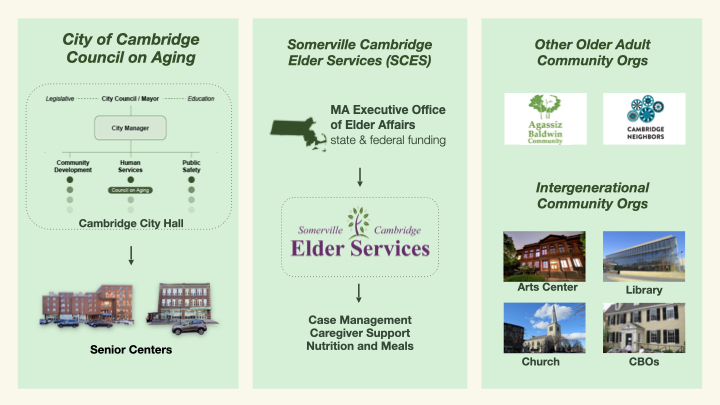
Stakeholder Interviews
To better understand existing infrastructure and programs servicing older adults in Cambridge, we conducted interviews with a few stakeholders in the local network of facilities and organizations:
Arline McGrady, Event Coordinator @ Cambridge Senior Center
Colleen Morrissey, Director of Volunteers & Special Projects @ Somerville Cambridge Elder Service
Micheline Federman, representative on the Advisory Council @ Somerville-Cambridge Elder Services (SCES), volunteer @ the Money Management program
Vincent McCarthy, Director of Client Services @ Cambridge Council on Aging
Susan Stockard, retired property management executive, who directed a research project on models for delivering health and social services to elders in public housing.
We were also in touch with Boston’s Executive Office of Elder Affairs (EOEA) and learned more about the broader policy landscape and outlook on aging and elder services in Boston.
We learned that Boston/Cambridge is actually well-equipped in terms of elder services and infrastructure, despite which, we identified 3 major challenges:
- People are not aware of existing programs
- They might not readily identify themselves as “elders’ who need these services
- Some programs are inaccessible due to barriers like transportation, lengthy application processes (and the subsequent long wait), and arbitrary threshold for age and income level that render them illegible for services
“People don’t want to go to a ‘senior’ center.”
“They don’t want to admit that they need help with something so personal.”
DESIGN
Care-A-Van
Care-a-van is a mobile dining hall and community hub that goes around different local neighborhood to host intergenetaionl programs. it brings private work done by volunteers inside people’s homes into open public places, or takes the work of non-profits & senior centers inside their facility space outside into the community. We are focusing on food-related programming that encourages story-telling as a way to pass down cultural heritages.
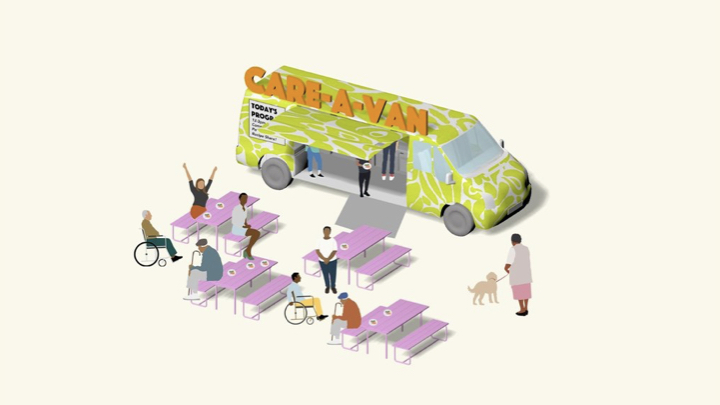
Uplift existing + build new infrastructure
Care-A-Van is not an attempt to reinvent the wheel and discount existing programs that are doing a phenomenon job servicing older adults in local communities; rather, it’s an addition that uplifts existing work done by local organizations, institutions, and non-profits through making existing programs housed in the senior centers or private spaces mobile and accessible and bringing the social activities to the elders.
It also builds new ones that focuses on mutual care and intergenerational interactions by tapping into existing resources like volunteers, funding programs, and communication channels to further enrich social activities in different enclaves and communities, offering additional opportunities for older adults and volunteers to socialize, with activities such as:
- Cooking
- Recipe sharing
- Personal Care
- Knitting/crocheting
- Exchange stories and life advice
Prototyped Design + Operation
Care-a-Van has two modes of activation:

with some sample programming and event schedule:
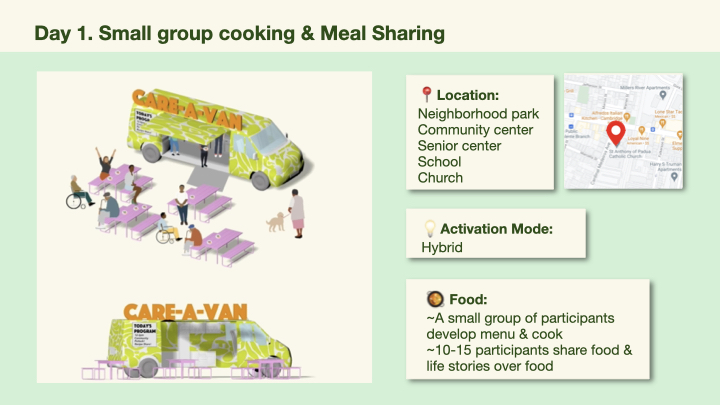

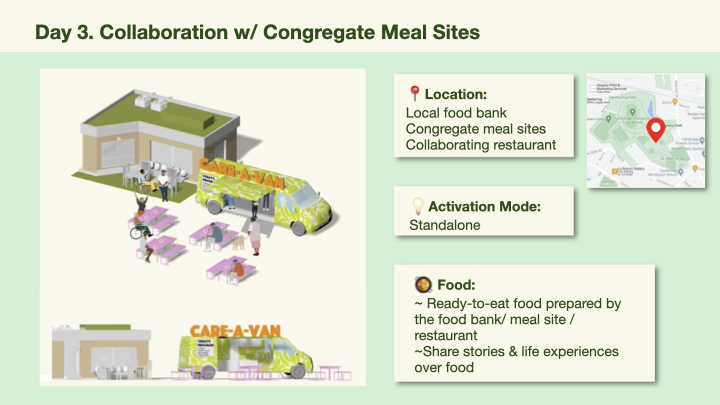
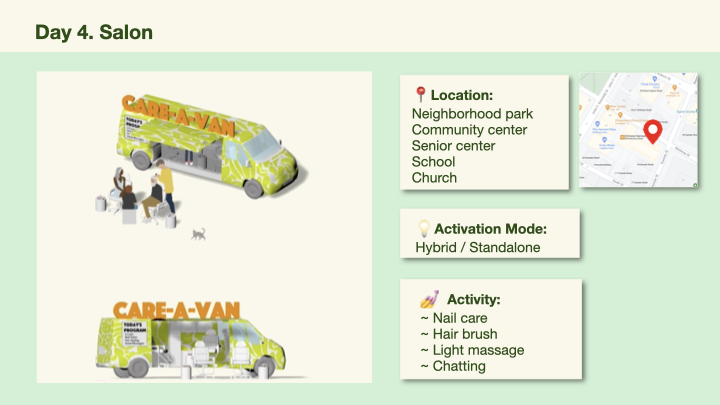
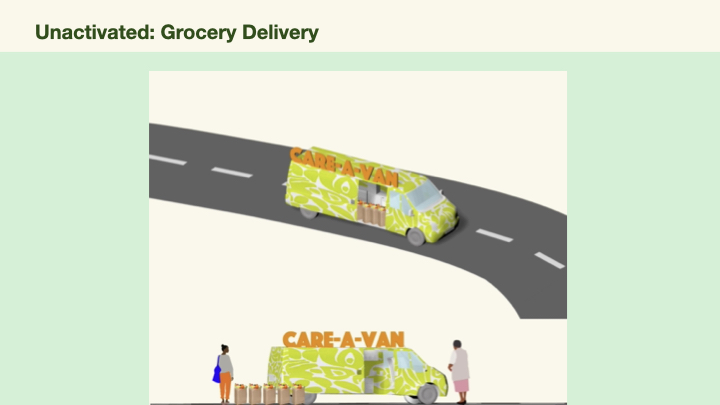
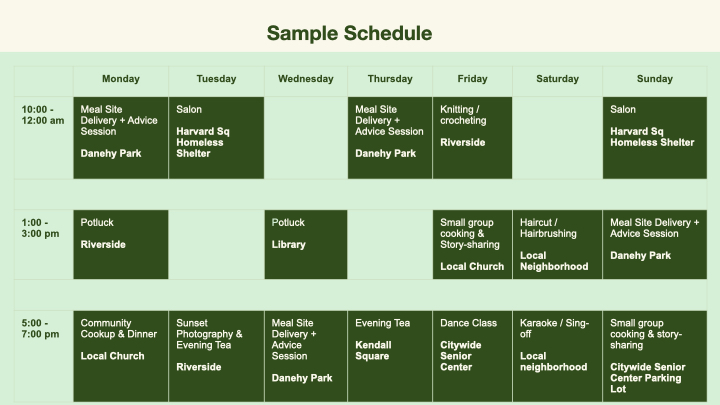
Implementation Strategy
We have conducted further research and located potential partner organizations and host organization, to which our proposal is made. We have devised a corresponding implementation strategy, including roll-out plan, roster, projected budget for construction and maintenance, and additional non-event based programming such as a periodic zine.
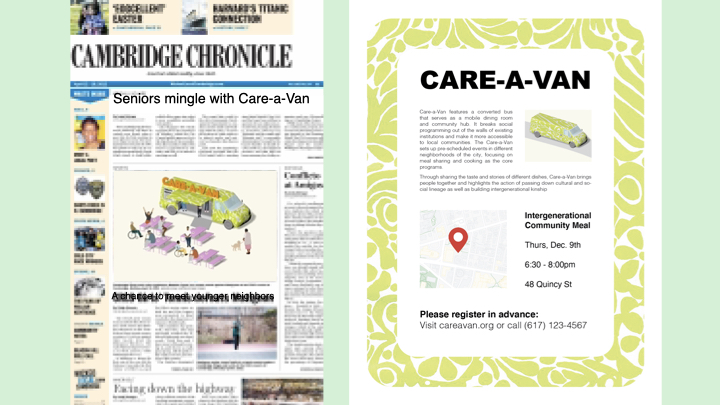
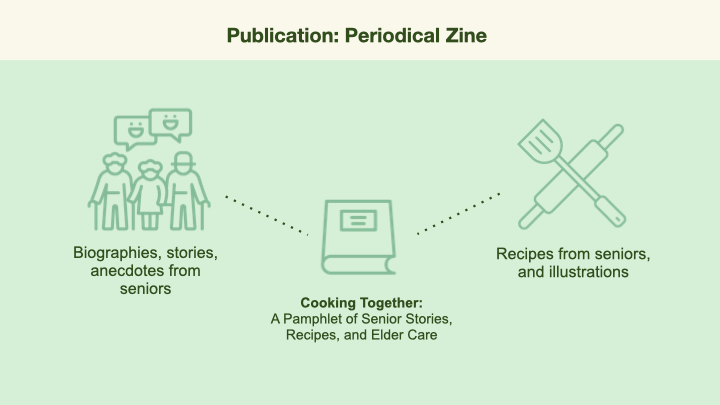
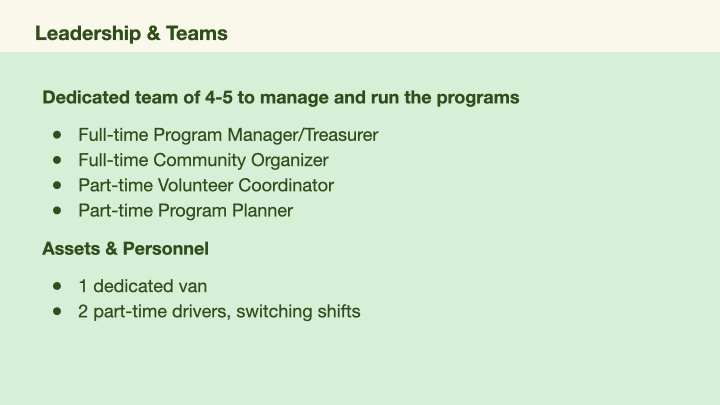
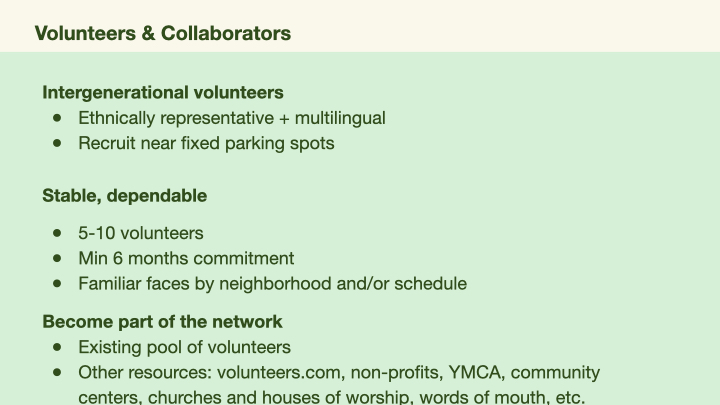
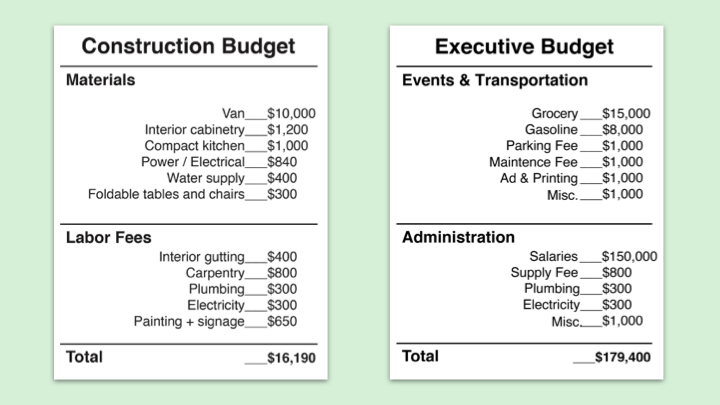
Read more in detail in our presentation deck here.
REFLECTION
Aging is universal
Like many people we have spoken to, I hold a special place in my heart for older adults and elder services, because I grew up with my grandparents (who are aging and living on a different continent from me), and I‘ve volunteered at local senior homes throughout high school. One of the moments that really stuck with me throughout the process of developing this project is from a conversation with one of the stakeholders. She told us that many volunters in elder service programs not only see it as a mean to engage in the community after moving to a new town, they are also volunteering because they hope that, when in need, their own parents and grandparents in a different city can also receive the help and care they need.
This is a reminder that aging is and will always be a universal topic. We are all aging, and have aging loved ones. Design for accessibility and elders is really design for all.
Possible improvements
While I’m exxtremely proud of our team from what we were able to accomplish in a semester, there are always something that can be improved. In this case, one of my major regrets for this project is that we were not able to talk to any of the “regular” elders who are users or beneficiaries of these elder service programs, though most of the stakeholders we’ve spoken to more or less fall under the “older adult” category. There were some hoops we had to jump through and some strict guardrails around speaking to program participants, and if I were to do this project again, I would’ve planned for that earlier, whether that’s through applying for any IRB permissions, or find other channels to recruit elders.